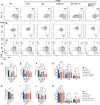Intrinsic STING of CD8 + T cells regulates self-metabolic reprogramming and memory to exert anti-tumor effects
- PMID: 39972350
- PMCID: PMC11837649
- DOI: 10.1186/s12964-025-02069-3
Intrinsic STING of CD8 + T cells regulates self-metabolic reprogramming and memory to exert anti-tumor effects
Abstract
Background: Our team has previously found that the stimulator of interferon genes (STING) plays a more significant anti-tumor role in host immune cells than in tumor cells. Although STING is necessary for CD8 + T cells to exert immunological activity, its effect on CD8 + T cells remains debatable. In this study, we used both in vitro and in vivo models to explore the metabolic effects of STING on CD8 + T cells.
Methods: Peripheral blood lymphocytes were procured from non-small cell lung cancer (NSCLC) patients receiving anti-PD-1 therapy to investigate the correlation between STING expression levels, CD8 + T-cell subsets, and immunotherapy efficacy. STING knockout (STING-KO) mice were used for in vivo studies. RNA-seq, seahorse, flow cytometry, electron microscopy, qPCR, immunofluorescence, western blotting, and immunoprecipitation were performed to explore the underlying mechanisms of STING in regulating CD8 + T cell function.
Results: We discovered that the expression level of STING in immune cells exhibited a significant correlation with immunotherapy efficacy, as well as with the proportion of central memory CD8 + T cells. Moreover, we found that the loss of the STING gene results in a reduction in the number of mitochondria and a change in the metabolic pathway selection, thereby inducing excessive glycolysis in CD8 + T cells. This excessive glycolysis generates high levels of lactate, which further inhibits IFN-γ secretion and impacts memory T cell differentiation. Correcting the glycolysis disorder partially restored function and IFN-γ secretion, rescued the central memory CD8 + T subset, and improved immunotherapy in STING-KO mice. This provides a new treatment strategy for patients with low STING expression and a poor response to immunotherapy.
Conclusion: Intrinsic STING of CD8 + T cells affects their function through the HK2/Lactate/IFN-γ axis and affects memory differentiation by regulating glycolysis.
Keywords: CD8 + T cells; Glycolysis; Immunotherapy; Metabolic reprogramming; Non-small cell lung cancer; STING.
© 2025. The Author(s).
Conflict of interest statement
Declarations. Data statement: The datasets used and/or analyzed during the current study are available from the corresponding author on reasonable request. Ethical approval and consent to participate: This study was approved by the Ethics committee of Jinling Hospital. All participants provided written informed consent. All animal experiments were performed following the guidelines of the Institutional Animal Care and Use Committee of the Southeast University Medical College. Competing interests: The authors declare no competing interests.
Figures









References
-
- Martínez-Reyes I, Chandel NS. Cancer metabolism: looking forward, Nature reviews. Cancer. 2021;21:669–80. - PubMed
MeSH terms
Substances
Grants and funding
- 82370096/National Natural Science Foundation of China
- BE2019719/Jiangsu Provincial Social Development - Key Projects - Clinical Frontier Technologies
- BE20197180/Jiangsu Provincial Social Development - General Program
- 2023JCYJZD080/Science and Technology Innovation Research Project of Jinling Hospital
LinkOut - more resources
Full Text Sources
Medical
Research Materials

